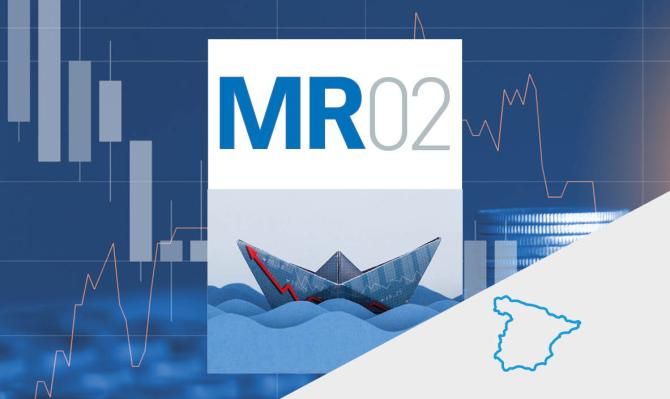The Spanish economy ended 2023 on a good note and kicks off 2024 with optimism
While in December 2022 our GDP growth forecast for 2023 was 1%, finally the Spanish economy has managed to grow by an impressive 2.5%, in spite of the geopolitical uncertainty, persistent high inflation (despite its decline in recent months) and rising interest rates.

While in December 2022 our GDP growth forecast for 2023 was 1%, finally the Spanish economy has managed to grow by an impressive 2.5%, in spite of the geopolitical uncertainty, persistent high inflation (despite its decline in recent months) and rising interest rates. This positive surprise is mainly explained by the faster-than-expected fading of the energy crisis (recall the sharp drop in gas prices in the final weeks of 2022 and, above all, in Q1 2023), as well as by the strong performance of Spain’s foreign sector, which was closely linked to both tourism and non-tourism services. In the coming quarters, the Spanish economy will continue to face a challenging context marked by geopolitical uncertainty and interest rates at restrictive levels, particularly given the lag with which interest rates affect the real economy, which means that their macroeconomic impact will continue to be felt during the opening weeks of 2024. However, there are also some elements of the economy that will support growth, such as the acceleration of the deployment of NGEU funds and the buoyancy of consumption, propped up by stronger household finances and the gradual recovery of purchasing power. Inflation, while remaining above 2%, is likely to continue to moderate. All this suggests that we will see an improvement during the course of 2024 and that the Spanish economy will likely continue to grow above the euro area average.

Specifically, in Q4 2023, GDP grew by 0.6% quarter-on-quarter (2.0% year-on-year), an improvement compared to both Q3 (0.4% quarter-on-quarter) and what was expected by the consensus of analysts. It should be noted that the composition of growth, according to preliminary data from the National Statistics Institute, shows an improvement in domestic demand thanks to the resilience of private consumption and the pull of public consumption. Domestic demand contributed 0.5 pps to quarter-on-quarter GDP growth, thanks to the increase in both public consumption, which contributed 0.3 pps, and private consumption, contributing 0.2 pps, which more than offset the sluggish performance of investment. Foreign demand, meanwhile, made a positive contribution of 0.1 pp to quarterly GDP growth, after two quarters of negative contributions, driven by a significant rebound in trade flows (in Q4 2023, both exports and imports recorded substantial gains of +2.9% and +2.7% quarter-on-quarter, respectively). The better-than-expected GDP growth in Q4 will lead us to revise upwards our 2024 growth forecast due to the drag effect generated by the higher growth in Q4 2023.


In January, the Purchasing Managers’ Index (PMI) for the manufacturing sector climbed 3 points, reaching 49.2 points, just shy of the threshold denoting growth (50) but suggesting that the deterioration of industrial activity is moderating. Also, the counterpart indicator for the services sector advanced 0.6 points to 52.1 points, placing it firmly within expansive territory. With regard to registered workers affiliated with Social Security, according to the data the year started on a good footing. Although the number of registered workers fell, as is usual in the month of January, in seasonally adjusted terms employment registered an increase of 38,000 affiliates, which represents an acceleration compared to the monthly average in Q4 2023 (31,250). Also, on the consumer side, the CaixaBank Research consumption tracker shows that spending using Spanish cards was more buoyant in January, with 5.6% year-on-year growth, compared to 5% in December and 7% in November.

Headline inflation truncated its recent downward trend and rose to 3.4% in January, 0.3 pps above the December figure. In contrast, core inflation (which excludes energy and unprocessed food) fell 0.2 pps to 3.6%. As the National Statistics Institute pointed out, the slight upturn in headline inflation in January is explained by the rise in electricity prices. This increase partly reflects the rise in taxes applicable to electricity bills (for example, VAT on electricity rose from 5% to 10% on 1 January). However, these upward dynamics in the electricity component were partly mitigated by the fall in fuel prices.

In the year up until November, exports of goods showed a slight reduction of 0.7% year-on-year, while imports fell considerably (–6.8% year-on-year), affected to some extent by the lower energy prices. Thus, the trade deficit to November stood at –2.9% of GDP, representing a substantial improvement compared to the –5.1% recorded in the first 11 months of the previous year. This fall in the trade deficit occurred at the same time as a dramatic improvement in the services surplus. Specifically, the cumulative surplus in services to November was 6.8% of GDP (6.1% in November 2022), supported by the enviable health of tourism, which closed 2023 with extraordinary figures. In 2023 as a whole, tourist arrivals exceeded 85 million, 1.9% more than in 2019, and they spent 18.2% more than in 2019.
